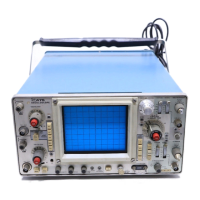TM 11-6625-2735-14-1
Visual Inspection
The instrument should be inspected occasionally for
such defects as broken connections, broken or damaged
ceramic strips,
improperly seated semiconductors,
damaged or improperly installed circuit boards, and heat-
damaged parts.
The corrective procedure for most visible defects is
obvious; however, particular care must be taken if heat-
damaged components are found. Overheating usually
indicates other trouble in the instrument; therefore, it is
important that the cause of overheating be corrected to
prevent recurrence of the damage.
Lubrication
The fan motor and most of the potentiometers used in
the 475 are permanently sealed and generally do not
require periodic lubrication. The switches used in the 475,
both cam- and lever-type, are installed with proper
lubrication applied where necessary and will only rarely
require any additional lubrication. It is recommended that
a regular periodic lubrication program not be performed
on any of the components used in the 475.
Semiconductor Checks
Periodic checks of the transistors and other semicon-
ductors in the 475 are not recommended. The best check
of semiconductor performance is actual operation in the
instrument.
Recalibration
To ensure accurate measurements, check the calibra-
tion of this instrument in accordance with TB 43-180. In
addition, replacement of component may necessitate recali-
bration of the affected circuits. The calibration procedure
can also be helpful in localizing certain troubles in the
instrument. In some cases, minor troubles maybe revealed
and/or corrected by recalibration. Complete calibration
instructions are given in TB 11-6675-2735-35-1.
TROUBLESHOOTING
Introduction
The following Information is provided to facilitate
troubleshooting of the 475. Information contained in other
sections of this manual should be used along with the
following information to aid in locating the defective
component. An understanding of the circuit operation is
helpful in locating troubles, particularly where integrated
circuits are used. See the Circuit Description section for
this information.
Troubleshooting Aids
Diagrams. Complete circuit diagrams are given on
foldout pages in the Diagram section. The component
number and electrical value of each component in this
instrument are shown on the diagrams (see first page of
the Diagrams section for definition of the reference
designators and symbols used to identify components in
this instrument). Each main circuit is assigned a series of
component numbers. Table 4-1 lists the main circuits in
the 475 and the series of component numbers assigned to
each. Important voltages and waveforms are also shown
on the diagrams. The portions of the circuit mounted on
circuit boards are enclosed with blue lines.
Circuit Board illustrations. To aid in locating circuit
boards in the instrument, a circuit board location illustra-
tion is placed on the back of the pullout page preceding
the circuit diagram. An illustration of the circuit board,
with circuit components of the following circuit diagram
identified, is also included on this page. Each circuit board
illustration is arranged to facilitate rapid physical location
of components listed on the schematic diagrams.
Component Locations Illustrations. To aid in locating
test points and components, the Component Locations
pages permit very rapid location of test points and com-
ponents.
Resistor Color-Code. In addition to the brown com-
position — resistors, some metal-film resistors and some
wire-wound resistors are used in the 475. The resistance
values of wire-wound resistors are usually printed on the
body of the component. The resistance values of composi-
tion resistors and metal-film resistors are color-coded on
the components with EIA color-code (some metal-film
resistors may have the value printed on the body). The
color-code is read starting with the stripe nearest the end
of the resistor. Composition resistors have four stripes,
which consist of two significant figures, a multiplier, and a
tolerance value (see Fig. 4-2). Metal-film resistors have
five stripes consisting of three significant figures, a
multiplier, and a tolerance value.
Capacitor Color-Code.
The capacitance values of
common disc capacitors and small electrolytics are
marked on the side of the component body. The white
ceramic and epoxy-coated tantalum capacitors used in
the 475 are color-coded, using a modied EIA code (see
Fig. 4-2).
4-6

